The use of wireless applications . is continuously increasing in the society. Together with the overall increased use of electronics in general, the total electromagnetic environment is increasing around wireless systems. The effect of interference does not always appear as interruption in communication, but can appear as more or less gradually performance degradation for the user. In this article, some of these interference consequences are discussed and examplified.
The overall use of wireless technologies is constantly increasing in the society . A large variety of applications incorporates wireless technology, in a spectrum from non-demanding social media applications to more demanding critical applications. Examples of critical applications are in the area of security and safety, machine-to-machine (M2M) communication, automotive applications, banking and financial systems, energy production, transport and logistics. Other specific examples are applications for remote control of trains and communication for landing and take-off of aircrafts.
Furthermore, the use of wireless-based sensors is also increasing in the civilian society. Examples are radars for detection of moving objects for collision avoidance, or detection of burglars in buildings. The amount of devices with wireless technology has had a tremendous growth the last years and it is foreseen that the number of devices will grow even further with the development of the next generation of mobile systems, 5G and Massive Internet of Things (IoT). Here, co-location densities up to 250 000 units per km2 are forecasted [1][2]. Wireless communication has several advantages, such as low production cost, high flexibility and low cost for installation. However, all wireless technologies are sensitive to electromagnetic interference signals and therefore means challenges from an Electromagnetic Compatibility (EMC) point of view.
The constantly increase of wireless and non-wireless electronics in society also means that the total electromagnetic interference environment increases. This will in general result in increased interference challenges for wireless devices and it is therefore important to have knowledge about how such interference problems may appear in the systems. It is not always, an interference problem appears as an interruption in the communication service. Several other gradually degradations may occur and some typical examples are discussed below. To make efficient troubleshooting in identifying a suspected interference problem in wireless devices, it is important to have some knowledge of how the more or less diffuse consequences may appear.
Practical Consequences of interference
The most familiar consequence on wireless systems from electromagnetic interference may be interruption in the communication link. In that case, the user immediately notices that a problem has occurred. However, several other more or less gradually degradations in quality of service may also occur. Electromagnetic interference can cause different kinds of practical consequences e.g.
- Interruption
- Reduced communication range
- Lost calls
- Time delay of data
- Error in the application
- Reduced number of users
- Increased sensitivity against other electromagnetic interference
- Shorter detection range for wireless sensors/systems
Each of these practical consequences will be briefly discussed below.
Interruption
If the level of electromagnetic interference is that large that the receiver no longer can detect the desired signal, interruption occurs. For digital wireless systems, the transition from good communication quality to interruption typically goes very rapidly. This is due to the basic properties for digital modulation and coding techniques. A practical consequence of this rapid behaviour is that the operator has very small opportunities to react and take actions before the interruption occurs. In one moment, the communication seems to work well and the next moment interruption occurs. This transition region is visualized by the yellow region in Figure 1a and 1b. In Figure 1a, a TETRA (Terrestrial Trunked Radio) communication receiver is co-located to a field hospital containing medical equipment that radiates electromagnetic interference. Interruption occurs if the receiver is co-located in the red colored area. In the yellow area, the communication quality is significantly reduced and goes from good communication quality (green area) to interruption within a few meters.
The figure is produced in the tool GENESIS, specially developed to analyse the impact from electromagnetic interference on wireless communications. In Figure 1b, the TETRA receiver is co-located in the vicinity of an ambulance that contains a computer that radiates electromagnetic interference. Even in this case, the short transition region (yellow area) between functioning and interruption is very narrow.
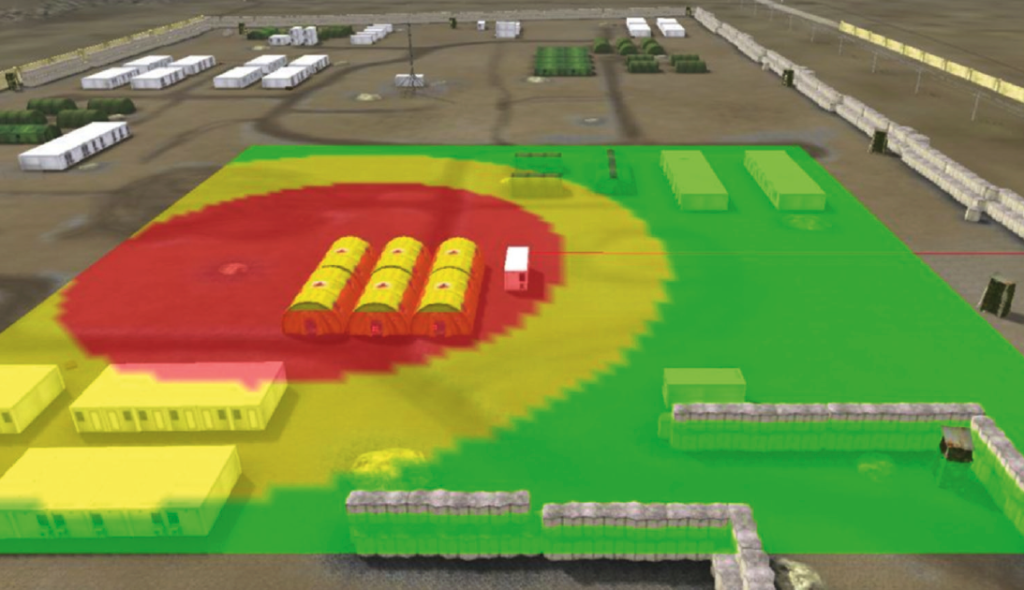
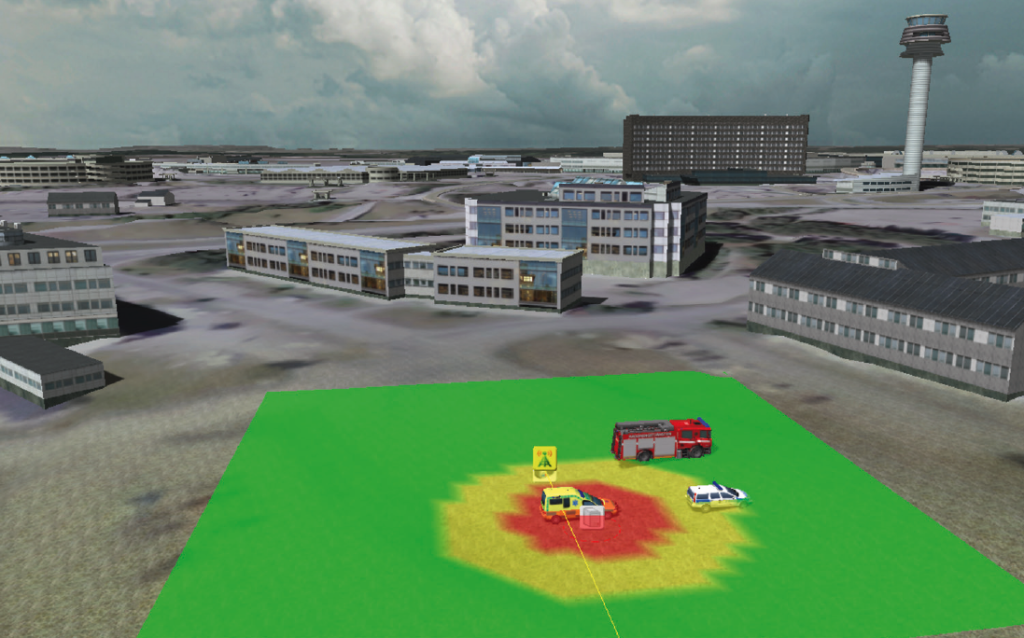
In Figure 2, a radio system is co-located in the vicinity of electronic equipment with unintentional electromagnetic interference. In this case, several buildings affects the radio signal as well as the interference. The yellow-colored transition areas between functioning communications and interruption are only found in a few places. This illustrates a typical behaviour of digital radio systems exposed to varying high and low levels of interference when moving across a surface.
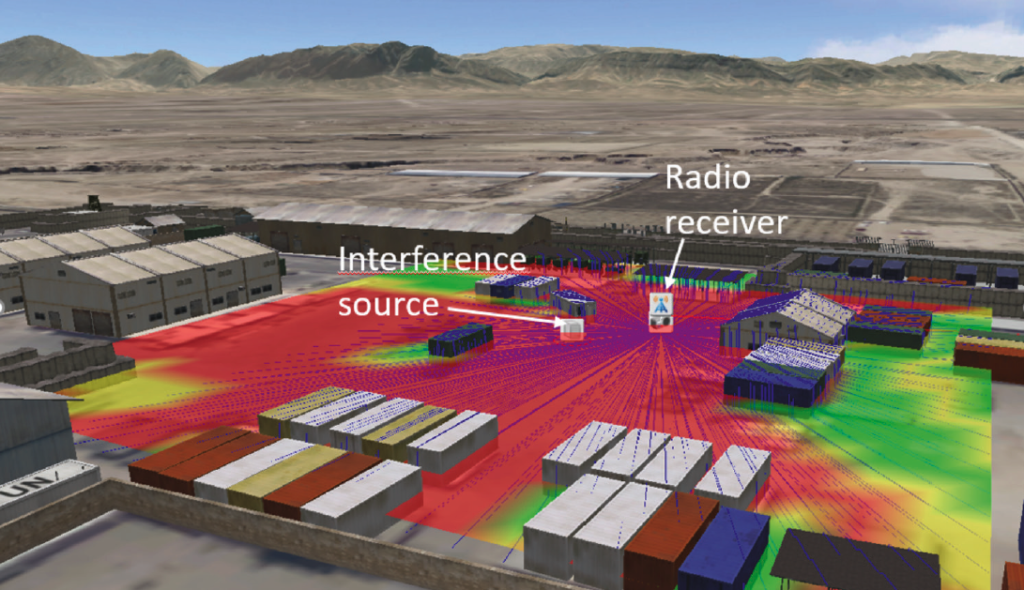
Reduced communication range and lost calls
If a wireless receiver is subjected to interference from co-located equipment, the total noise level in the receiver will increase and in turn reduce the communication range for others to reach the receiver. The problem in this case is that the operator, close to the interference source, may not recognize that an interference problem has occurred. This is the case as long as the actual communication distance is within the reduced range so that interruption has not yet occurred, see Figure 3.
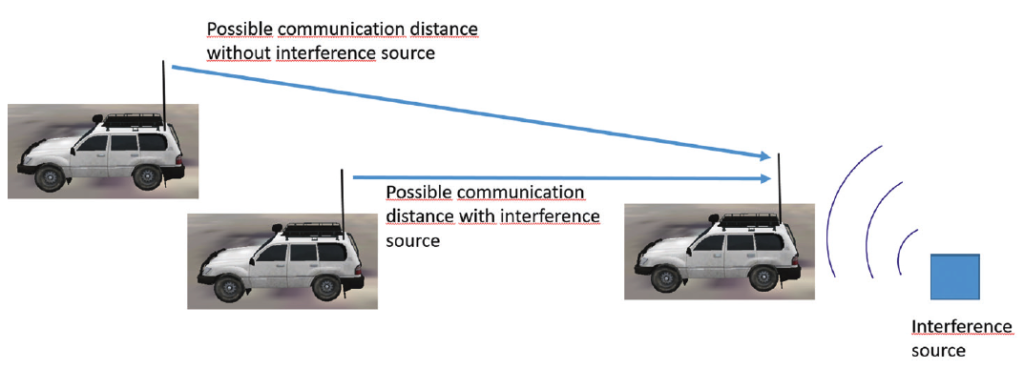
Any reduction in communication range may cause calls to the transceiver with interference to be lost. However, the non-disturbed transceiver in the same communication link can still receive traffic from the disturbed transmitter, which may cause confusion for the operators in each end of the link. This since one operator can receive calls and the other cannot. To maintain the original communication distance, the desired signal level to the disturbed receiver has to be increased. If it is not possible to increase the output power of the non-disturbed system, the only way is to move closer to the disturbed system. Therefore, the communication range is reduced as a result of the interference.
In Figure 4a, a corresponding analysis is done for a TETRA-communication receiver in the vicinity of an ambulance that contains electronics with radiated interference. In this case, 83% of the possible communication range is achieved. In GENESIS, the reduction in communication range is automatically analyzed for every interference scenario. Thus, even if the interference has not caused interruption, an indication of the severity of the interference problem is done. In Figure 4b, a radio for air-traffic control communications is co-located with a solar-panel systems that radiates according to EN 55022. The radio system is analog and uses amplitude modulation for voice communications.
In this case, only 68% of the possible communication range is achieved. Thus, the operator will not recognize that there is an interference problem as long as the radio system in the other end of the link is still at a distance within the reduced communication range.
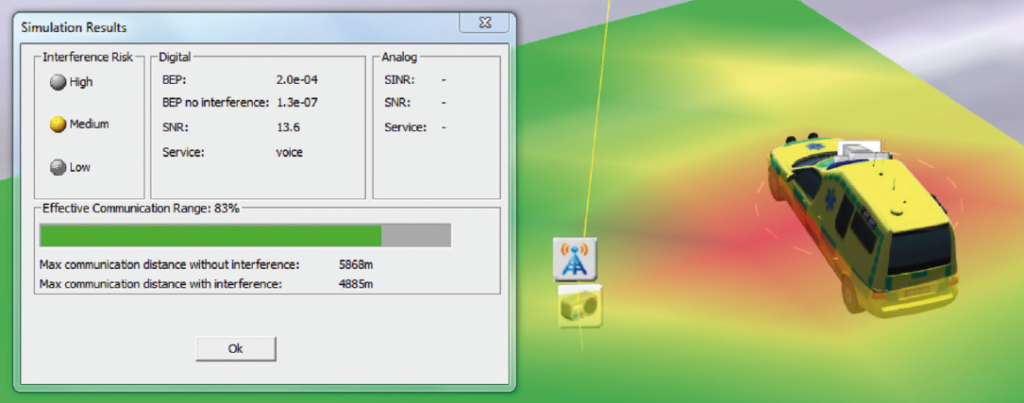
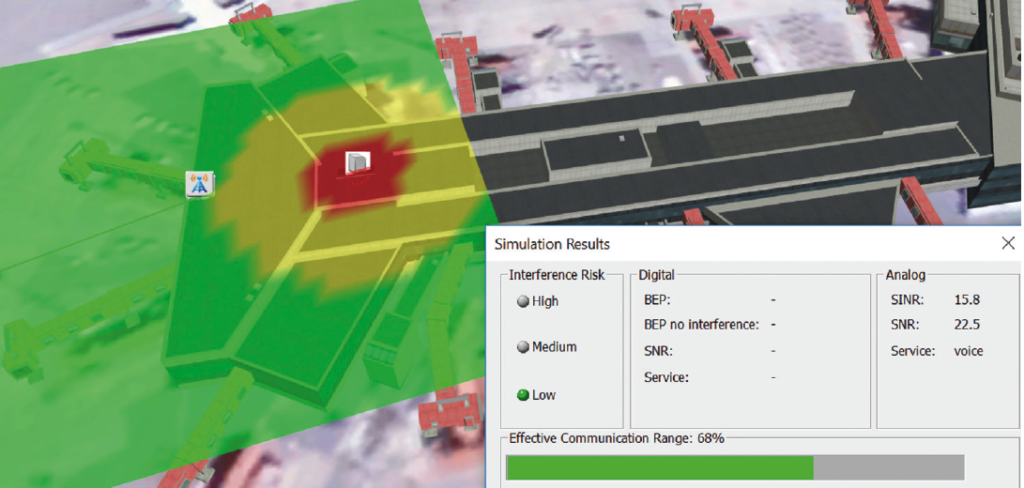
Time delay of data
Some wireless systems reacts to interference by trying to retransmit the traffic a moment later. This is the case for systems using e.g. Carrier Sense Multiple Access (CSMA) or ARQ (Automatic Repeat Request). CSMA is used in modern Wi-Fi networks. If there is interference in the frequency band of use, the system will try to retransmit data at a later stage. This will appear as an increased time delay for the users. The IEEE 802.11p is developed for use in wireless communication systems between vehicles and infrastructure, in particular for intelligent transport system (ITS) and safety-related applications. In IEEE 802.11p both ARQ and CSMA are used.
ARQ is a method to perform error control in data packets. If the sender does not receive an acknowledgment before a specified timeout, it usually re-transmits the packet until the sender receives an acknowledgment or exceeds a predefined number of retransmissions. An analysis of time delay as the result of interference at the radio channel for IEEE 802.11p is shown for IEEE 802.11p in [3].
Error in the application
In some applications, an interference problem can result in errors in the actual application, even if the system seems to work properly. One example is GPS (Global Positioning System) where some GPS receivers continues to deliver position information, but incorrectly, even if there is interference on the received signal.
Reduced number of users
Some communication systems such as the 3G-UMTS mobile system, are interference limited with respect to the number of simultaneous users. In UMTS all users contributes to the total interference for a single user. This means that if the total interference has increased due to other interference sources, the number of users has to be reduced to obtain the desired communication quality.
Increased sensitivity against other electromagnetic interference
The increase in noise level, caused by electromagnetic interference will also reduce the margin against other potential interference problems in an uncontrolled manner. In general, communication links are designed to have a certain interference margin if unexpected interference occurs or if the desired signal is temporarily reduced due to e.g. physical changes in the surrounding environment (e.g. signal fading). Electromagnetic interference from the surrounding environment will reduce this margin and make the system more sensitive to changes in the communication signal strength.
Shorter detection range for wireless sensors/systems
Sensors that relies on the ability of detecting a wireless signal will have reduced capability if the desired signal is mixed with electromagnetic interference. This means that to maintain the sensor capability in terms of e.g. detection range, the desired signal has to be increased in order to compensate for the increased interference level. If the sensor is e.g. a radar, the desired signal is the reflected signal from surrounding objects. If the output radar signal cannot be increased, the only way to increase the reflected signal is to move closer to the object. Thus, the interference gives a reduced detection range for the radar, see Figure 5.
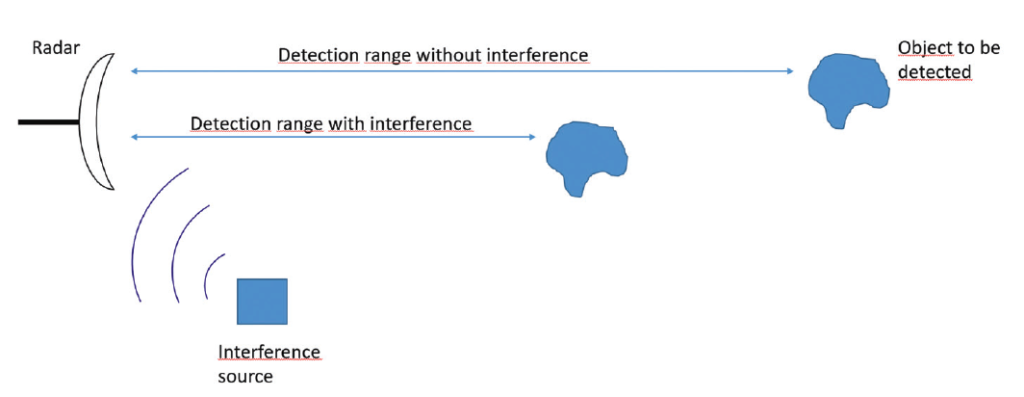
Conclusion
Electromagnetic interference can appear as different consequences in a wireless application. Since interruption is just one of several possible consequences, a careful interference analysis needs to consider other possible consequences that might occur in the application.
Peter Stenumgaard, Sara Linder The Swedish Defence Research Agency (FOI)
References
[1] Wiklundh, K; Stenumgaard, P, “EMC Challenges for the Era of Massive Internet of Things”, IEEE Electromagnetic Compatibility Magazine, pp. 63-72, vol. 8, Q2, 2019.
[2] Specification 3GPP TS22.26, “Service requirements for next generation new services and markets”, 2018.
[3] Örn Tengstrand, S; Fors, K; Stenumgaard, P; Wiklundh, K, “Jamming and interference vulnerability of IEEE 802.11p”, Proceedings of EMC Europe 2014, International Symposium on Electromagnetic Compatibility 1-4 Sept, Gothenburg, Sweden, pp 533-538.


